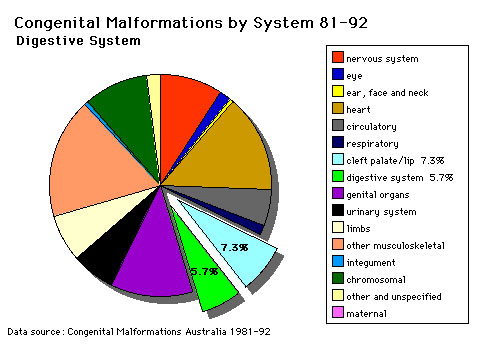BGDB Gastrointestinal - Activity 4: Difference between revisions
mNo edit summary |
mNo edit summary |
||
| Line 32: | Line 32: | ||
|} | |} | ||
{{BGDB GIT2019}} | |||
==Additional Information== | |||
{{Med Prac additional Information}} | |||
{{BGDBFooter}} | {{BGDBFooter}} | ||
Revision as of 12:15, 13 April 2019
| Practical 1: Activity 1 | Activity 2 | Activity 3 | Activity 4 |
Learning Activity 4
- Describe the fetal and early post-natal changes of the gut.
- Identify the common abnormalities of the gut.
- Identify the diagnostic techniques associated in testing gut function.
1. Fetal and Postnatal Changes
2. Common Abnormalities
Gastrointestinal Tract Defects of all notifiable birth defects in Australia (1981-1992)
The table below shows the most recent ICD-11 coding for congenital gastrointestinal abnormalities.
| ICD-11 Structural developmental anomalies of the digestive tract |
|---|
|
LB10 Structural developmental anomalies of salivary glands or ducts | LB11 Congenital diverticulum of pharynx | LB12 Structural developmental anomalies of oesophagus | LB13 Structural developmental anomalies of stomach | LB14 Structural developmental anomalies of duodenum | LB15 Structural developmental anomalies of small intestine | LB16 Structural developmental anomalies of large intestine | LB17 Structural developmental anomalies of anal canal | LB18 Congenital anomalies of intestinal fixation | Structural developmental anomalies of the liver, biliary tract, pancreas or spleen | Inborn Errors of Metabolism |
| gastrointestinal abnormalities |
| ICD-11 LB15.0 Meckel diverticulum - congenital abnormality characterized by the outpouching or sac formation in the ileum. It is a remnant of the embryonic yolk sac in which the vitelline duct failed to close. During early gestation, the ompahlomesenteric or vitelline duct connects the fetal yolk sac to the primitive gut. By 7-8 weeks of gestation, this duct is normally completely obliterated. A Meckel diverticulum results when this structure fails to resorb completely. |
- What is oesophageal atresia (EA) and what are the possible developmental causes?
- What is the most common gastrointestinal motility abnormality of the newborn?
3. Gut Diagnostics
| Interactive component |
|---|
| Practical 1: Activity 1 | Activity 2 | Activity 3 | Activity 4 |
Additional Information
| Additional Information - Content shown under this heading is not part of the material covered in this class. It is provided for those students who would like to know about some concepts or current research in topics related to the current class page. |
BGDB: Lecture - Gastrointestinal System | Practical - Gastrointestinal System | Lecture - Face and Ear | Practical - Face and Ear | Lecture - Endocrine | Lecture - Sexual Differentiation | Practical - Sexual Differentiation | Tutorial
Glossary Links
- Glossary: A | B | C | D | E | F | G | H | I | J | K | L | M | N | O | P | Q | R | S | T | U | V | W | X | Y | Z | Numbers | Symbols | Term Link
Cite this page: Hill, M.A. (2024, April 24) Embryology BGDB Gastrointestinal - Activity 4. Retrieved from https://embryology.med.unsw.edu.au/embryology/index.php/BGDB_Gastrointestinal_-_Activity_4
- © Dr Mark Hill 2024, UNSW Embryology ISBN: 978 0 7334 2609 4 - UNSW CRICOS Provider Code No. 00098G
